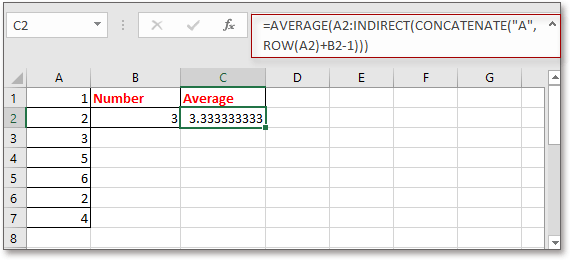Cum se definește intervalul pe baza unei alte valori a celulei în Excel?
Pentru majoritatea utilizatorilor Excel este ușor să calculați un interval de valori, dar ați încercat vreodată să calculați un interval de valori pe baza numărului dintr-o anumită celulă? De exemplu, există o coloană de valori în coloana A și vreau să calculez numărul de valori din coloana A pe baza valorii din B2, ceea ce înseamnă că, dacă este 4 în B2, voi medie primele 4 valori în coloana A, după cum se arată în imaginea de mai jos. Acum introduc o formulă simplă pentru a defini rapid intervalul bazat pe o altă valoare a celulei în Excel.
Definiți intervalul pe baza valorii celulei
 Definiți intervalul pe baza valorii celulei
Definiți intervalul pe baza valorii celulei
Pentru a face calculul pentru un interval bazat pe o altă valoare a celulei, puteți utiliza o formulă simplă.
Selectați o celulă goală pe care veți scoate rezultatul, introduceți această formulă = MEDIE (A1: INDIRECT (CONCATENATE ("A", B2))), și apăsați Intrați cheie pentru a obține rezultatul.
1. În formulă, A1 este prima celulă din coloana pe care doriți să o calculați, A este coloana pentru care calculați, B2 este celula pe care calculați. Puteți schimba aceste referințe după cum aveți nevoie.
2. Dacă doriți să faceți un rezumat, puteți utiliza această formulă = SUMA (A1: INDIRECT (CONCATENATE ("A", B2))).
3. Dacă primele date pe care doriți să le definiți nu se află pe primul rând din Excel, de exemplu, în celula A2, puteți utiliza formula astfel: = MEDIE (A2: INDIRECT (CONCATENATE ("A", ROW (A2) + B2-1))).
Numărați rapid / Sumați celulele după culoare de fundal sau format în Excel |
| În unele cazuri, este posibil să aveți o gamă de celule cu mai multe culori, iar ceea ce doriți este să numărați / să sumați valori pe aceeași culoare, cum puteți calcula rapid? cu Kutools pentru Excel's Numără după culoare, puteți face rapid multe calcule după culoare și, de asemenea, puteți genera un raport al rezultatului calculat. Faceți clic pentru o încercare gratuită completă în 30 de zile! |
 |
| Kutools pentru Excel: cu peste 300 de programe de completare la îndemână Excel, gratuit pentru a încerca fără limitări în 30 de zile. |
Cele mai bune instrumente de productivitate de birou
Îmbunătățiți-vă abilitățile Excel cu Kutools pentru Excel și experimentați eficiența ca niciodată. Kutools pentru Excel oferă peste 300 de funcții avansate pentru a crește productivitatea și a economisi timp. Faceți clic aici pentru a obține funcția de care aveți cea mai mare nevoie...

Fila Office aduce interfața cu file în Office și vă face munca mult mai ușoară
- Activați editarea și citirea cu file în Word, Excel, PowerPoint, Publisher, Access, Visio și Project.
- Deschideți și creați mai multe documente în filele noi ale aceleiași ferestre, mai degrabă decât în ferestrele noi.
- Vă crește productivitatea cu 50% și reduce sute de clicuri de mouse pentru dvs. în fiecare zi!
